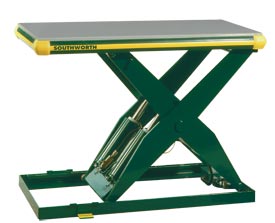
Using a Lift Table for Pallet Offloading
Austin Trusty | 29 April 2015
With limited fork lift resources, one manufacturer installed a pallet handling system that used a lift table, floor pit, and pallet conveyor to improve cycle times and reduce traffic in a busy assembly area.
Two things often associated with pallet handling systems are fork lift trucks and lift truck drivers. Facilities are often in need of both, but with the addition of these items, also comes the addition of risks. ToolboxTopics.com explains further, “OSHA estimates forklifts cause about 85 fatal accidents per year; 34,900 accidents result in serious injury; and 61,800 are classified as non-serious.
According to the Industrial Truck Association (ITA), there are about 855,900 forklifts in the U.S. Therefore, over 11% of all forklifts will be involved in some type of accident each year. The ITA also reports that the useful life of a lift truck is about 8 years. This means that about 90% of all forklifts will be involved in some type of accident during their useful life--again assuming only one accident per forklift.” If given the opportunity, wouldn’t you prefer to eliminate or not introduce these risks?
With the right amount of foresight and given the right circumstances, it makes sense to keep lift truck travel to a minimum within your pallet handling system to avoid unnecessary injury. While forklifts are a critical part of many warehousing facilities, there are solutions that can be installed to reduce the need and overall travel time of your forklift labor. For one manufacturer, we implemented a pallet handling system that compensated for limited forklift resources and improved assembly area cycle times.
The Application:
Pallet handling conveyor delivers fully loaded pallets to the assembly area. Pallets (40” x 48”) are loaded with empty glass fish tanks stacked 84" tall. Pallets are to be offloaded from the conveyor system to assembly workers for sealing, labeling, and wrapping before the skid is ready for shipping.
The Problem:
The existing facility had limited resources available for pallet offloading in the assembly area—a limited number of lift trucks and lift truck drivers. How can we offload these delicate pallets?
The Solution:
The solution consists of (3) three major components:
1. A Lift Table A few things to consider -
- How many cycles will there be per day? (up and down)
- What are the load specs? (weight, center of gravity, and offloading method)
- Safety features (beveled toe guarding and traffic sensors)
2. A Floor Pit A few things to consider -
- Maintenance access (conveyor size, pit size, and power supply)
- Safety features (lock out/tag out, safety chocks, flood sump pump)
 3. A Pallet Conveyor A few things to consider -
3. A Pallet Conveyor A few things to consider -
- Pallet specs (size, weight, and offloading method)
- Pallet orientation (direction bottom boards are traveling)
- Offloading method (pallet jack offloading will likely require tread plate inserts and different roller centers on the conveyor)
Advantages:
- Lower risk of forklift accidents in a busy assembly area
- Decreased the amount of stand by time in assembly area if forklift is not available
- Increased the life span of the offloading pallet conveyor
- Decreased cycle times in the assembly area
- Increased forklift efficiencies elsewhere in the facility
We found that it would be ideal for assembly workers to offload at their own pace, which would eliminate the stand by time associated with waiting for a lift truck driver to offload the pallet from the conveyor. Giving workers the ability to offload also eliminates any associated risk with having a lift truck interface with the pallet and pallet conveyor in an already busy assembly area.
With minimal upfront cost and a planned maintenance schedule on the lift table, the customer now has a very nice solution in place to lower risk, decrease cycle times, and achieve higher efficiencies. For more information, please visit our pallet handling section or contact us.
Austin is Sr. Field Application Engineer with Bastian Solutions’ Indiana regional team. He has a Bachelor of Science in Mechanical Engineering Technology from Indiana University - Purdue University at Indianapolis. As an FAE, Austin works closely with customers and their automation needs. Austin has a strong background in material and information flow, as well as general business operations.
Comments
No comments have been posted to this Blog Post
Leave a Reply
Your email address will not be published.
Comment
Thank you for your comment.